Feminist science fiction is a subgenre of science fiction focused on theories that include feminist themes including but not limited to gender inequality, sexuality, race, economics, and reproduction. Feminist SF is political because of its tendency to critique the dominant culture. Some of the most notable feminist science fiction works have illustrated these themes using utopias to explore a society in which gender differences or gender power imbalances do not exist, or dystopias to explore worlds in which gender inequalities are intensified, thus asserting a need for feminist work to continue.
Science fiction and fantasy serve as important vehicles for feminist thought, particularly as bridges between theory and practice. No other genres so actively invite representations of the ultimate goals of feminism: worlds free of sexism, worlds in which women's contributions are recognized and valued, worlds that explore the diversity of women's desire and sexuality, and worlds that move beyond gender.
The New Wave is a movement in science fiction produced in the 1960s and 1970s and characterized by a high degree of experimentation in both form and content, a "literary" or artistic sensibility, and a focus on "soft" as opposed to hard science. New Wave writers often saw themselves as part of the modernist tradition in fiction, and the New Wave was conceived as a deliberate break from the traditions of pulp science fiction (SF), which many of the New Wave writers involved considered irrelevant and unambitious. The New Wave science fiction writers of the 1960s thus emphasized stylistic experimentation and literary merit over the scientific accuracy or prediction of hard science fiction writers.

Ursula Kroeber Le Guin was an American author best known for her works of speculative fiction, including science fiction works set in her Hainish universe, and the Earthsea fantasy series. She was first published in 1959, and her literary career spanned nearly sixty years, yielding more than twenty novels and over a hundred short stories, in addition to poetry, literary criticism, translations, and children's books. Frequently described as an author of science fiction, Le Guin has also been called a "major voice in American Letters." Le Guin herself said she would prefer to be known as an "American novelist".

Always Coming Home is a 1985 science fiction novel by Ursula K. Le Guin. It is in parts narrative, pseudo-textbook and pseudo-anthropologist's record. It describes the life and society of the Kesh people, a cultural group who live in the distant future long after modern society has collapsed. It is presented by Pandora, who seems to be an anthropologist or ethnographer from the readers' contemporary culture, or a culture very close to it. Pandora describes the book as a protest against contemporary civilization, which the Kesh call "the Sickness of Man".
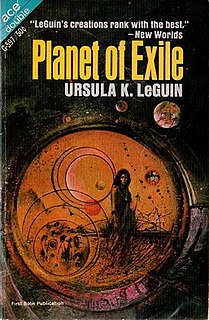
Planet of Exile is a 1966 science fiction novel by American writer Ursula K. Le Guin, part of her Hainish Cycle. It was first published as an Ace Double following the tête-bêche format, bundled with Mankind Under the Leash by Thomas M. Disch. In 2017, the rights for a movie were acquired by Los Angeles Media Fund.
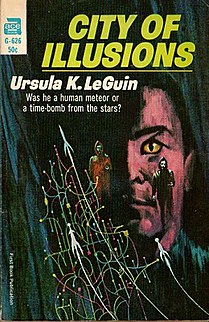
City of Illusions is a 1967 science fiction novel by American writer Ursula K. Le Guin. It is set on Earth in the distant future, and is part of her Hainish Cycle. City of Illusions lays the foundation for the Hainish cycle which is a fictional world in which the majority of Ursula K. Le Guin's science fiction novels take place.

Four Ways to Forgiveness is a collection of four short stories and novellas by American writer Ursula K. Le Guin. All four stories are set in the future and deal with the planets Yeowe and Werel, both members of the Ekumen, a collective of planets used by Le Guin as part of the background for many novels and short stories in her Hainish Cycle. In 2017 it was reissued as an e-book, augmented with a fifth related story by Le Guin, as Five Ways to Forgiveness.

An extraterrestrial or alien is any extraterrestrial lifeform; a lifeform that did not originate on Earth. The word extraterrestrial means "outside Earth". The first published use of extraterrestrial as a noun occurred in 1956, during the Golden Age of Science Fiction.

The Telling is a 2000 science fiction novel by Ursula K. Le Guin set in her fictional universe of Hainish Cycle. The Telling is Le Guin's first follow-up novel set in the Hainish Cycle since her 1974 novel The Dispossessed. It tells the story of Sutty, a Terran sent to be an Ekumen observer, on the planet Aka, and her experiences of political and religious conflicts between a corporatist government and the indigenous resistance, which is centered on the traditions of storytelling, locally referred to as "the Telling".
Lee John Harding is an Australian freelance photographer, who became a writer of science fiction novels and short stories.
Leon Eugene Stover was an anthropologist, a Sinologist, and a science fiction fan, who wrote both fiction and nonfiction. He was a scholar of the works of H. G. Wells and Robert A. Heinlein and an occasional collaborator with Harry Harrison.
"Winter's King" is a science fiction short story by American writer Ursula K. Le Guin, originally published in the September 1969 issue of Orbit, a fiction anthology. The story is part of the Hainish Cycle and explores topics such as the human effect of space travel at nearly the speed of light, as well as religious and political topics such as feudalism.

"The Shobies' Story" is a 1990 science fiction novella by American writer Ursula K. Le Guin, describing the story of the first human crew to participate in a newly invented faster-than-light mode of space travel. It was first published in the anthology Universe 1 and subsequently appeared in A Fisherman of the Inland Sea published by Harper Prism in 1994.
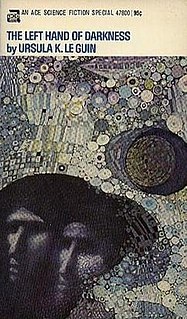
The Left Hand of Darkness is a science fiction novel by U.S. writer Ursula K. Le Guin. Published in 1969, it became immensely popular, and established Le Guin's status as a major author of science fiction. The novel is set in the fictional Hainish universe as part of the Hainish Cycle, a series of novels and short stories by Le Guin, which she introduced in the 1964 short story "The Dowry of the Angyar". It was fourth in sequence of writing among the Hainish novels, preceded by City of Illusions, and followed by The Word for World Is Forest.

Soft science fiction, or soft SF, is a category of science fiction with two different definitions.
- It explores the "soft" sciences, and especially the social sciences, rather than engineering or the "hard" sciences.
- It is not scientifically accurate or plausible; the opposite of hard science fiction.

Best SF: 1968 is the second on a series of annual anthologies of science fiction stories edited by Harry Harrison and Brian W. Aldiss, first published in a British edition in January 1969 by Sphere Books. The first American edition was released later that year by Putnam, with a Berkley paperback following shortly thereafter. Severn House issued a British hardcover edition in 1977.
"The Matter of Seggri" is a science fiction novelette by American writer Ursula K. Le Guin. It was first published in 1994 in the third issue of Crank!, a science fiction – fantasy anthology, and has since been printed in number of other publications. In 2002, it was published in Le Guin's collection of short stories The Birthday of the World: and Other Stories. "The Matter of Seggri" won the James Tiptree Jr. Award in 1994 for exploring "gender-bending" and has been nominated for other honors including the Nebula Award.
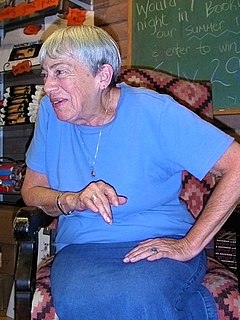
"Coming of Age in Karhide" is a science fiction short story by Ursula K. Le Guin, first published in 1995. The story is set on the fictional planet of Gethen, the same as Le Guin's 1969 novel The Left Hand of Darkness, and is a part of Le Guin's Hainish cycle. The story explores themes of growing into adulthood on a planet where individuals have no fixed gender identity. Reviewers stated that the story went further than Left Hand in its exploration of gender and sexuality, and was a "quietly feminist" work. It was also described as lacking the "dizzying impact" of Left Hand. In 2002, it was anthologized in the volume The Birthday of the World, along with many other stories exploring marriage and sexual relationships.

"Old Music and the Slave Women" is a science fiction story by Ursula K. Le Guin. It was first published in the 1999 collection Far Horizons, edited by Robert Silverberg, and anthologized multiple times in collections of Le Guin's works. The story is set on the planet of Werel in the fictional Hainish universe, created by Le Guin. That planetary system is also the setting for Le Guin's 1995 story suite Four Ways to Forgiveness. The economy of Werel is based on slavery, and during the period in which the stories are set, the society is experiencing upheaval and revolution.
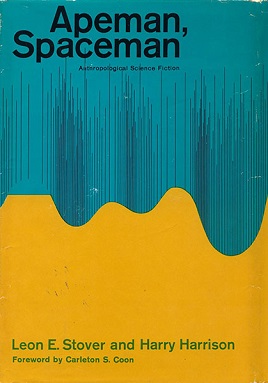
Apeman, Spaceman: Anthropological Science Fiction is an anthology of science fiction short stories edited by Harry Harrison and Leon E. Stover. It was first published in hardcover by Doubleday in June 1968, with a paperback edition following from Berkley Medallion in March 1970. The first British editions were issued in hardcover by Rapp & Whiting in October 1968 and in paperback by Penguin Books in November 1972. The book has been translated into German.












